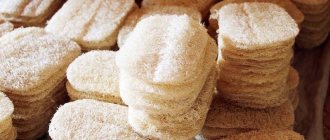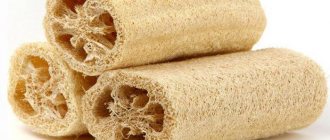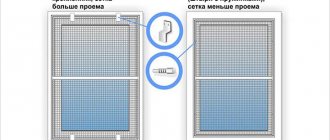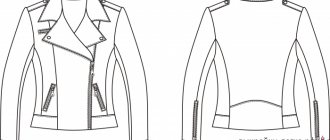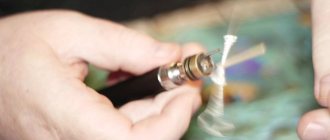Every housewife has at least once thought about reusing the multi-colored string bag in which fruits and vegetables are sold in supermarkets. Thanks to our master class, you can bring this idea to life and assemble a washcloth from a mesh with your own hands in just 5–10 minutes. This washcloth is good for washing dishes, other household chores, bathing and showering. It foams well and dries faster than store-bought ones.
Choosing your natural washcloth
Washcloths made from plant materials not only perform the main function of caring for the human body, but also provide an additional healing effect. Typically the material used is:
- Bast is the subcortical layer of linden, subject to special steam treatment. Has medium abrasiveness. During use, it releases phytoncides that help treat diseases of the upper respiratory tract.
- Loofah (pictured) is the dried fibrous fruit of a plant from the pumpkin family. Provides a good skin massage.
- Sisal is a fiber made from agave leaves with a woven or knitted structure. Allows you to deeply cleanse the skin, providing excellent peeling and anti-cellulite effect. Increases blood circulation intensity.
- Rami. Thanks to their mesh structure, ramie washcloths help smooth the skin, cleanse pores and improve overall body tone. They also provide a good anti-cellulite effect, gently polishing without scratching the skin.
No less useful and in demand are natural washcloths made from bamboo, jute, rubber, volcanic pumice, and sea sponge.
One of the disadvantages of natural washcloths is their fragility. In the plant environment, pathogenic bacteria quickly multiply, and rotting processes are observed - regardless of the quality of sponge care (heat treatment, washing).
The service life of natural washcloths is short. Compared to their synthetic counterparts, they break down much faster. In addition, as they are used, they quickly become worn out and pathogenic microorganisms are more likely to appear in them.
Doctors say that washcloths made purely from natural materials are more useful, since only they can improve a person’s well-being and mood in a record short time. However, you need to understand that each product has its own pros and cons.
One of the trends in the modern market is that natural products are slowly but surely replacing analogues made from artificial materials. The reason for this is that every year there are more and more people leading a healthy lifestyle.
Disadvantages of washcloths made from natural materials: • noticeably inferior to synthetic products in terms of service life; • dry for a long time; • this is a favorable environment for microorganisms; • require care, which consists of thorough washing, drying in well-ventilated places and treatment with antibacterial agents.
Linen washcloths
The healing properties of flax products were known to our ancestors. After the Second World War, scientists were puzzled by scientific research into the properties of flax. The results of these studies made it possible to confirm folk wisdom regarding flax and its ability to relieve ailments. Linen products stimulate blood circulation and have a beneficial effect on the psyche.
Unfortunately, linen washcloths are a rare “inhabitant” of store shelves.
Loofah sponges
Loofah is a plant belonging to the Cucurbitaceae family. You can often hear the second name of this representative of the plant world – “mad cucumber”. Loofah fruits are very similar to zucchini. If desired, you can make a washcloth from such material at home. When ripe, the inside of the fruit is dry and fibrous. Therefore, to obtain a washcloth, it is enough to dry them, then soak them in water so that the skin softens, and peel the “cucumbers” and remove the pulp from the inner fibers. The washcloth is ready. All that remains is to wash it in soapy water and dry it in the sun.
It is impossible not to note the strength and long service life of such washcloths. Of course, these hygiene accessories have disadvantages: • foam does not form on the surface of the washcloth; • before use, the washcloth is pre-soaked in hot water. This softens the material.
Loofah washcloths are a great purchase for people with oily skin. For people with thin and sensitive skin, a washcloth is not suitable: it is too rough. According to customer reviews, the presentation of washcloths-mittens after several water procedures leaves much to be desired, so it is better to purchase washcloths from a single piece.
Sisal washcloths
Sisal is a coarse, durable material derived from the leaves of the Mexican agave plant. Ropes, twines, mattresses, brushes and washcloths are made from it. Typically, such washcloths are produced in the form of woven mittens that have high peeling properties. Due to their hardness, these washcloths should be used a maximum of twice a week. Sisal washcloths are primarily recommended for people fighting cellulite.
It is better to avoid such a hygiene accessory if you have delicate skin or a large number of moles. These washcloths require pre-soaking, do not hold foam well and are quite expensive, but they exfoliate old cells well and last a long time.
Bast sponges
Not only bast shoes and matting are woven from non-woody wood, but also washcloths, which are considered a bath masterpiece of naturalism, obtained from the lower part of the bark of a young linden tree. There is an opinion that such washcloths are the most beneficial for the skin.
We invite you to familiarize yourself with: Mixture for plastering the stove: composition and proportions of the solution for plastering with your own hands
Don't be afraid that the bast sponge will be too hard. In water, bast softens and gently exfoliates dead cells, deeply cleanses pores, and also releases phytoncides. This version of washcloths does not shine with durability, but this is justified by their cheap price.
Ramie washcloths
In stores you can often see woven washcloths made from ramie - Chinese nettle. In terms of hardness, such washcloths are somewhere between loofah and sisal. A hygiene product made from Chinese nettle, like all hard washcloths, has anti-cellulite and massage properties. Only, unlike other hard washcloths made from natural raw materials, these are gentle on the skin, gently sanding it.
Bristle washcloths
Such accessories are produced in the form of brushes, the material for which is natural bristles. The design feature of such washcloths is a long wooden handle. They provide deep cleansing of the skin from dirt, dust and dead cells. These washcloths are great for massaging problem areas. The massage is performed in a circular motion from the wrists to the shoulders, from the legs to the thighs, bypassing the chest and areas with lymph nodes. A 2-5 minute procedure is sufficient.
Birch bark washcloths
Birch bark is a rich source of the natural antiseptic betulin, which contains many silver ions. The biological role of betulin is to protect the tree from fungal diseases and pests (it is the reason for the white color of the bark of birch trees).
Birch bark washcloths have a good scrubbing effect and help fight orange peel.
But, like all natural products, native Russian washcloths are not cheap, and they are also a rare commodity. Disadvantages of birch bark washcloths: before use, the washcloth should be soaked in boiling water for 10-15 minutes; Dry thoroughly after washing.
♦ How to weave a box and casket from birch bark
♦ Hut on a chicken leg - birch bark craft
Eco-scrubbers
The material for such washcloths is cellulose. Although they are made of wood, they feel soft and elastic to the touch. Outwardly, they are very similar to foam sponges, but differ in their fibrous structure. Washcloths have a lot of advantages: soft; beat the foam well; after drying, they become hard, so they do not collect microbes inside them.
Sea sponges
These are very delicate washcloths, obtained from primitive multicellular organisms, subjected to special processing, after which only a “skeleton” remains of them. Washcloths are sold in solid form, but after soaking they acquire a soft, porous structure. Once dry, the sponges harden again, which prevents germs from growing in them.
You probably won’t find a more delicate natural washcloth. True, the price of sea sponges is steep, and this is even with a short service life. Sponges should be changed every two to three months.
Dish scrubber
To make your own washcloth, you will need 2-4 meshes. It is advisable to wash them first and trim the ends with scissors.
Further course of action:
- Roll the longest net (or several) into a rope.
- Press the ends of the tourniquet to the middle.
- Secure them with a small mesh, also rolled into a flagellum.
- Straighten the edges to form a beautiful bow.
- Ready!
A foam sponge breaks down very quickly. A vegetable mesh washcloth is much more durable, and it is still convenient to use. Try it!
How to fix a mesh washcloth. How to put it back together)
15368 93 9
מאת: Tatyana Glushko People amp; Blogs
Mesh washcloths are not made to last. However, among them there may be both longer-lasting ones and shorter ones. My new bow-shaped washcloth was purchased from the Pyaterochka chain for 51 rubles. This is not a high price, but I still expected that the purchase would serve me well for the required 3 months. To my regret, it completely blossomed within a week of use.
Place your hand inside the net and slide it over your hand like a stocking.
Using your free hand, gather one edge of the mesh into a pile.
Holding the edge, remove the structure and grab the other edge of the mesh with your other hand. You've got an elastic donut.
Continuing to hold opposite edges, turn the donut until it looks like an infinity sign.
Hold the resulting squiggle with one hand. Wrap the second around it with the cord that originally held the washcloth together.
Pass one end of the cord through the other and pull tight.
Spread the edges around the circumference to create a “rose”.
Wash with pleasure!
PS To hold the washcloth tighter, tie another knot. Slide the outer end of the cord under the part that is wound around the core of the washcloth. The result is a loop; insert the end of the cord into it and tighten it.
06 Aug 2022 OLga 211
Useful hand-made: making accessories for the soul and shower with your own hands
Sea sponges
A shower sponge is an intimate personal hygiene device that is found in every home. Lately, high-quality sponges and washcloths that can be used to wash really well have become increasingly rare on sale.
All of them are made of synthetic fabric, and their weaving is sometimes very far from ideal. Therefore, reasonable remarks that any similar bathroom accessory can be bought in a store are not very appropriate here.
Soft or hard?
In the refrigerator and on the brush. Where do bacteria most often accumulate?
Bast washcloths are thin strips of bast that can be tied into a bun or sewn onto a fabric base. The bast itself is made from the inner bark of linden or other deciduous trees. Bast sponges are good for baths, but they are not recommended for use in ordinary bathrooms: the material crumbles and can clog the drain.
Suitable for: bast is a fairly hard material, so it can be used for deep cleansing of the skin. The washcloth can be softened a little by dipping it in boiling water for 10-15 minutes before use.
It is better not to use if you have delicate skin or if you prefer to shower with foam - the bast loofah does not foam well.
We suggest you read: How to decorate walls in a bathhouse
Loofah (sometimes spelled luffa) has recently become a popular material for bath accessories. It is a dried vine fruit that has been freed from the skin and seeds. Loofah can be found in the form of a roll, cut into pieces or “packed” in soap.
Who is it suitable for: the loofah is quite hard, so it can be used for peeling and anti-cellulite massage during water treatments.
It is better not to use for people with delicate skin and those who want to maintain a tan longer - a hard washcloth quickly erases the top layer of skin.
Linen washcloths are famous for their durability, ability to absorb water well and lather well. Items for water procedures can be knitted from linen threads or sewn from linen. In the second case, a piece of soap is sometimes placed inside the washcloth.
Suitable for: lovers of foam bathing and allergy sufferers.
It is better not to use for people with particularly delicate skin.
Sisal fiber is also used to weave washcloths, which are quite stiff, but have enviable strength.
Suitable for: those who want to get rid of dead skin on their elbows and heels.
It is better not to use if you have sensitive skin.
Bristle brushes of different sizes and different hardness are suitable for the whole body: with an accessory on a long handle you can scrub your back, small brushes will clean your fingers and feet.
Suitable for: Those who like a good back rub
It is better not to use for those with sensitive skin, or choose especially soft bristles.
Toys will help to accustom your child to water procedures.
For sensitive and problem skin, you should not choose hard washcloths made of sisal, jute, or coarsely knitted washcloths made of polypropylene tape. They will irritate the skin and provoke excessive secretion of sebum.
A little history and purpose
It is not known for certain when the first devices appeared to help cleanse the skin, but already in references in Babylon and Ancient Greece there is information about the first washcloths. Wealthy people used wood or bronze to wash their skin, while poor people used bunches of plants or sand.
Now, a washcloth is already an absolutely necessary household item for every person. Beautifully designed, of different sizes, colors and purposes, they decorate the bathroom and are indispensable assistants in the bathroom.
A washcloth can be made from any available material: natural cotton or chintz, using old terry towels, woven from burlap, and for those who are not looking for easy ways - knitted.
Burlap washcloth
If you don’t know how to knit or don’t want to, you can make a beautiful washcloth with your own hands using burlap, for this you will need: burlap, foam rubber or sponge, gauze, soap and elastic, and also a piece of cotton fabric.
From burlap you need to cut two identical rectangles slightly larger than your palm, and the same ones for the gauze lining. A holder for a bath accessory is made using an elastic band, assembled like an accordion and covered with fabric. One end is secured in the middle of a burlap rectangle, and the other is sewn to the side.
Next, the burlap is sewn together to form a bag and pieces of soap and a sponge are placed in it to create foam; dried lavender or mint can be added for scent. The washcloth needs to be sewn up. It is ready to use. When the soap in it stops foaming, you will need to rip it open and pour in a new portion.
Massage sponges and bag of soap
casting on loops and knitting knit stitches. This pattern is called “garter stitch”, and it’s easy to do: cast on the required number of loops (the width of the future washcloth) and simply knit each row. As a result, you will get a ribbed fabric that will demonstrate massage qualities very well. You will get small nodules, which, when soaped, will have an anti-cellulite effect on the body.
If you have a little more experience in knitting and you already know how to knit purl stitches, then you can use the “tangle” pattern, also known as the “pearl pattern”, to create a washcloth. The emphasis in this version is on alternating knit and purl stitches in rows. For example, you knit the first row like a simple elastic band (knit one, purl one), and in the second row you swap the stitches:
Place them together and sew around the perimeter, leaving one side unstitched. Place a bar of soap inside and sew up the last part. But sew this side with light stitches, so that later you can unravel them and put a new piece of soap into the bag. If desired, it is also possible to make a handle for the bag so that it is convenient to hang it on a hook in the bathhouse or bathroom.
What’s convenient about using such an unusual washcloth is that you don’t have to take soap in a soap dish and a separate washcloth with you to the bathhouse. You can also save a lot of money if you sew inside it not a whole bar of soap, but several remnants of soap, which are usually thrown away because they are inconvenient to use. This washcloth can also be turned into a unique scrubbing item if you sew natural soap with the addition of coffee grounds inside it.
Polypropylene washcloth
To knit such a bath “helper”, it is enough to purchase the appropriate threads and a hook size 5-6 with a round head. Initially, you need to knit a chain of loops 20 cm long and connect them into a ring.
Next, you need to knit the main fluffy part of the washcloth using the “DC” method and finish with several rows of “SC”, and at the end knit the handles. This way you can knit a washcloth from any material.
These artificial materials, from which various shower sponges are most often knitted, are convenient because they are quite easy to work with. The thread does not fluff for obvious reasons and does not get tangled, so it is easy to handle both with crochet and knitting needles. Another positive factor of polypropylene yarn is the wide range of colors.
You need to knit from polypropylene with knitting needles and crochet no finer than number four or even number five. This thread is quite stiff, and therefore it is advisable not to pull it very tightly, since a washcloth that is too coarse is not suitable for use. Moreover, you need to be especially scrupulous about this issue if you plan to knit a washcloth for a child.
Polypropylene makes beautiful washcloths in the shape of a hedgehog toy. To do this, you will need threads of two different colors: darker - to create its needles and lighter - for the muzzle. You need to crochet a hedgehog with elongated loops as follows.
- Cast on 20 cm of loops with a dark thread, connect them into a ring and knit two rows with single crochets.
- Make several rows of elongated loops: pull out the loops two to three centimeters long and remove them from the hook, knitting the loops through one stitch.
- Knit with elongated loops 10 centimeters in height.
- Next, use light threads to knit the cone-shaped face of the animal.
- Knit according to this pattern - two single crochets, then skip the next loop and two double crochets again - so that the knitting begins to taper.
- Knit in this way until all the loops come together.
- Make the nose and eyes of the animal from black thread - and the washcloth is ready.
In addition, you can make a knitted washcloth in the shape of a mitten from polypropylene thread, which will be not only beautiful, but also a convenient bath accessory. Two identical parts of the product are knitted. First of all, you need to crochet 20 loops and knit five rows with single crochets. Then, to knit a finger at the end of the row, you should cast on eight air loops and tie them with double crochets.
Return to the main fabric and knit five more rows with single crochets, then begin to cut the loops, rounding the top of the mitten. To do this, do not knit one stitch from each edge of the knitting until the mitten is completely rounded. Complete the second part of the product in the same way and sew the finished halves together.
We suggest you read: How to assemble a log house yourself
For household needs
Together with a cleaning product, a mesh sponge can work wonders. With its help you can easily clean the bathtub, tiles, kitchen counters, and hob. For greater efficiency, you can make a strong donut washcloth with your own hands.
Master Class:
- Cut a square of approximately 15 by 15 cm from the mesh.
- Fold it in half.
- Take a thread and a needle and sew 2 edges of the resulting rectangle. Do not cut the thread.
- Fill the “pocket” with pieces of string bag through the remaining hole and sew it up too.
- Connect all 4 corners, secure with the same thread and sew to the center of the washcloth.
- Sew a few stitches to create an indentation in the middle. Secure the thread with a knot and cut.
You can not only put a net in the pocket, but also sew up remnants. You will get double savings - a free washcloth and detergent in one item.
Results
If you look at examples of photos of do-it-yourself washcloths in books, brochures, craft magazines or on the Internet, you will see what a variety of these bath items there are. In addition to the original accessory, spending a minimum of time and effort, you will receive a real decoration for the bathroom, an indispensable cleanser suitable for your skin and save money.
Such washcloths can be given as a gift or an addition to a gift, or they can also be sewn for children in the form of various animals or cartoon characters. The child will be more willing to bathe with such a gift.
Threads come in different thicknesses. The thicker the thread, the tougher the finished washcloth will be. Select threads of such thickness that it is convenient to use them for crocheting No. 3-4. Although the most delicate and soft washcloths are crocheted No. 2, i.e. thin threads. Some people like washcloths that are harder and denser, while others like them softer.
Buy bright threads to match your bath accessories. For children, it is better to knit a washcloth from thin threads in the shape of a mitten or a funny animal.
Before the first use, be sure to keep the washcloth in boiling water for 5-7 minutes, the washcloth becomes pleasant to the body and lathers well.
A washcloth with elongated polypropylene loops can be knitted in the form of a pipe in a circle. It is convenient to insert foam rubber into such a washcloth.
- You can knit a flat rectangular washcloth according to the usual pattern using single crochets (only every third row is knitted with elongated loops):
- The crocheted washcloth can be oval-shaped (in this case, every third row is also knitted with elongated loops):
- A washcloth can be crocheted in the form of a mitten:
- Round washcloth (do not forget to knit every 2 or 3 rows with elongated loops):
- A crocheted washcloth for a child can be crocheted in the shape of any toy.
There is one more nuance: the longer the loops, the softer the washcloth.
If you have never knitted with elongated loops, then you should first try to knit a sample from simple threads in order to practice and work out the tightness of the knitting. The fact is that you need to knit tightly with long loops, i.e. Tighten each loop with columns so that the fabric is not loose. It will be especially difficult for beginners to immediately knit elongated loops from polypropylene threads.
Options for knitting washcloths for beginners
Even a person who does not have much knowledge and experience in this type of needlework can knit a product with a hook. Beginners can try their hand at knitting a single-sided washcloth. In this version, they will hone their skills in order to move on to more complex ones in the future. The product is knitted with elongated loops, and the furry part will be on only one side. This element is simple to perform: you need to pull out loops a couple of centimeters long, as indicated in the diagram presented.
As a rule, such washcloths for beginners are made in a square shape to simplify the task as much as possible. The simplest option: cast on as many air loops as the width you want the product to be, and knit a couple of rows with single crochets. Then perform a row with elongated loops and a row with single crochets. Repeat this alternation until the length of the washcloth you desire. Also knit the last two rows with single crochets.
From one end of the square, knit enough chain stitches so that the chain reaches the other end of the square and hangs slightly. Secure the chain at the other end and cross it with single crochets. If you wish, you can knit two identical fabrics and sew them together by placing a piece of foam inside.
Knitting pattern for a round washcloth
The advantage of single-sided washcloths is that they dry faster after bath procedures. They also use a simple pattern, such as elongated loops, double and single crochets, and puffy stitches. All this is clearly visible in the finished product. And, besides, more complex patterns will simply not lather well and then take a long time to dry.
To make knitted washcloths, it is better to resort to the simplest elements possible. If we talk about material for crocheted accessories, it is best to take natural threads. For example, the following threads have proven themselves well in work and further use in the product:
They are quite harsh, which is good for thoroughly cleansing the body, and have a lot of positive health properties. You can also create a version of a bath sponge in the shape of a pipe. To do this, you also need to master the technique of making elongated loops.
The scheme of work is as follows.
- Cast on 23–25 centimeters with air loops and connect them into a ring.
- Knit 4 rows in a circle using single crochets.
- Alternate rows of single crochets with rows of elongated loops.
- Knit this way to the desired length of the washcloth.
- Finish with four rows of single crochets.
- Place a piece of foam rubber inside.
- Close the loops at both ends of the pipe and tie the handles.
Crochet washcloth video tutorials
Crochet washcloth. Master class from Noskova Nadezhda
The washcloth is crocheted in the round from elongated loops. Polypropylene threads.
Crocheted washcloth. Oksana's work
You will need yarn for knitting washcloths and a size 4 hook.
The washcloth is crocheted No. 2; it took half a skein of thread.
This washcloth is crocheted from propylene thread in 2 folds, with crochet number 5. It is knitted equally on both sides, with a “Fringe” pattern or elongated loops.
A washcloth-mitten, just like a regular washcloth, is knitted simply: 1 row of single crochets, 1 row of elongated loops.
Materials: – polypropylene threads of different colors; – crochet hook (select the size depending on the desired density of the washcloth - the smaller the number, the denser the product will be, and vice versa).
Author Irina Kachukova. For knitting you will need: yarn “Housewife - a needlewoman for the soul and soul” 50g, 100% polyamide, package 10x50g and a hook.
The knitting pattern is very simple:
- 3 rows of single crochets
- 3 rows of lush columns
How to knit lush columns, see the diagram below in the article.
You will need: polypropylene threads of 2 colors. hook No. 3 or No. 4, needle with a wide eye. The size of the finished washcloth is 14*21 cm.
Tags: washcloth, back, mesh, collect, diagram
« Previous entry
Kese washcloth
This washcloth is designed to remove dirt from the skin without the use of scrubs and cleansing gels. If a person has sensitive skin, it is made from natural fibers, silk; for coarser skin, it is made from sheep or goat wool.
Its homeland is the East; from ancient times to this day it has been woven in the traditional way - crocheted. First, you need to knit a handle of 40 loops with two threads, on the third, start knitting cap stitches to the end of the chain - the first handle is ready, we make the second in the same way and fasten its end to the first.
The main part of the washcloth consists of three stitches of 16 single crochets, connected to three stitches of 16 double crochets. The washcloth is ready!
It must be thoroughly washed with water and wrung out well to avoid the appearance of various bacteria and unpleasant odors, since the material used in the base does not dry well and retains moisture for a long time.
